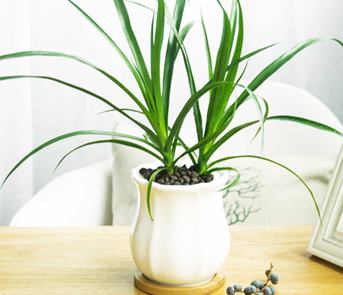How to raise the sword leaf dragon blood tree? can it be inserted alive?
When it comes to this sword-leaf dragon blood tree, it is very good-looking and suitable for viewing leaves. It is so green all the year round. Let's take a look at how to raise the sword-leaf dragon blood tree. Can the sword leaf dragon blood tree be inserted alive?

How to raise the dragon blood tree with sword leaves:
1. Temperature: the most suitable growth temperature of sword leaf dragon blood tree is 20-28 ℃, and the lowest growth environment in winter should be more than 8 ℃, otherwise it is very likely to stop growing or get frostbite.
2. Soil: the swordleaf dragon blood tree likes the soil which is loose, well drained and rich in humus. If the basin soil is too hard and too dry, it should be loosened in time to maintain air permeability.
3. Watering: the pot plant of Sword Leaf Dragon Blood Tree should not be watered too much, it can be watered once a week in the peak growing season, and less in the dormant period. at the same time, it can often spray water to the leaves to maintain high humidity.
4. Fertilization: raising sword leaf dragon blood tree needs more thin fertilizer, and it is more appropriate to apply fertilizer every 2-3 months. Solid compound fertilizer or farm manure can be selected for fertilization.
Can the sword leaf dragon blood tree be inserted alive?
Family potted plants generally choose cutting method to cultivate new plants. The sword leaf dragon blood tree can also be inserted alive.
1. Intercept the stem. Use a sharp knife to intercept a section of the stem of the sword leaf dragon blood tree, it is best to leave buds, easy to survive.
2. Dry the stem. Put the intercepted stem in a dry and ventilated place to dry slightly to avoid incision infection.
3. Prepare potted soil. Prepare new potted soil, apply enough base fertilizer, or buy special soil for flowers and put it in a flowerpot of the right size.
4. Replant. Intercept the blood stem of the stegosaurus into the soil, be careful not to insert it too deep, and keep the soil next to it soft to avoid squeezing.
5. Late nursing care. After planting, the stem needs careful care, no watering in the first 2-3 days, and then a small amount of watering every 3-4 days. When it is found to rejuvenate (such as sprouting new lateral buds), nursing measures such as fertilization are restored.
Tip: generally, after 1 month of cutting, the swordleaf dragon blood tree cuttings begin to sprout and take root.
On the sword leaf dragon blood tree breeding methods and cutting methods are introduced here, quickly raise one in your own home.
How to raise the sword leaf dragon blood tree? can it be hydroponically cultured?
The sword leaf dragon blood tree has a beautiful shape and is very suitable as a potted tree species to decorate the home environment. However, flower friends are very concerned about how to raise the sword leaf dragon blood tree. Can the sword leaf dragon blood tree be hydroponically cultivated? Can you plug it in? Let's take a look at it in detail.
How to raise the dragon blood tree with sword leaves:
1. Temperature: the most suitable growth temperature of sword leaf dragon blood tree is 20-28 ℃, and the lowest growth environment in winter should be more than 8 ℃, otherwise it is very likely to stop growing or get frostbite.
2. Soil: the swordleaf dragon blood tree likes the soil which is loose, well drained and rich in humus. If the basin soil is too hard and too dry, it should be loosened in time to maintain air permeability.
3. Watering: the pot plant of Sword Leaf Dragon Blood Tree should not be watered too much, it can be watered once a week in the peak growing season, and less in the dormant period. at the same time, it can often spray water to the leaves to maintain high humidity.
4. Fertilization: raising sword leaf dragon blood tree needs more thin fertilizer, and it is more appropriate to apply fertilizer every 2-3 months. Solid compound fertilizer or farm manure can be selected for fertilization.
Can the sword leaf dragon blood tree be hydroponically cultivated?
Generally speaking, hydroponic culture of sword leaf dragon blood tree can also be tried, but its survival rate may not be as high as that of other hydroponic plants. Sword leaf dragon blood tree growth rate is relatively slow, rooting is also relatively slow, in the process of hydroponic culture, if there are problems in maintenance, it can not grow new roots.
To change the soil culture of the sword leaf dragon blood tree into hydroponic culture, the root system needs to be washed and pruned properly, and then put into clean water to give it a period of time to adapt and grow new roots. Change the water once a day before rooting, and once a week after rooting, that is, pour out half of the water and then increase half of the water to maintain the balance of water quality. If it is found that the sword leaf dragon blood tree has not taken root for a long time, you can also add some rooting powder to the water to stimulate it to grow roots quickly.
Can the sword leaf dragon blood tree be inserted alive?
1. Intercept the stem. Use a sharp knife to intercept a section of the stem of the sword leaf dragon blood tree, it is best to leave buds, easy to survive.
2. Dry the stem. Put the intercepted stem in a dry and ventilated place to dry slightly to avoid incision infection.
3. Prepare potted soil. Prepare new potted soil, apply enough base fertilizer, or buy special soil for flowers and put it in a flowerpot of the right size.
4. Replant. Intercept the blood stem of the stegosaurus into the soil, be careful not to insert it too deep, and keep the soil next to it soft to avoid squeezing.
5. Late nursing care. After planting, the stem needs careful care, no watering in the first 2-3 days, and then a small amount of watering every 3-4 days. When it is found to rejuvenate (such as sprouting new lateral buds), nursing measures such as fertilization are restored.
Tip: generally, after 1 month of cutting, the swordleaf dragon blood tree cuttings begin to sprout and take root.
Can the sword leaf dragon blood tree be kept indoors? can it be hydroponically cultured?
To talk about this sword leaf dragon blood tree, there are still many people like, the long leaves are green all the year round, let's see if the sword leaf dragon blood tree can be kept indoors. Can the sword leaf dragon blood tree be hydroponically cultivated?
Can the sword leaf dragon blood tree be kept indoors:
Sword leaf dragon blood tree can also be put indoors, but flower friends had better choose smaller sword leaf dragon blood tree, so as not to occupy too much indoor space.
Sword leaf dragon blood tree itself is a master of decontamination, can absorb indoor waste gas, so as to purify indoor air and improve indoor humidity. Therefore, placing the sword leaf dragon blood tree at the entrance of the living room, the corner of the hall or next to the stairs is not only conducive to adjusting people's heart and gastrointestinal health, but also very conforms to fengshui and can bring good luck for the family.
If the bark of the stem of the sword leaf dragon blood tree is cut, it will secrete a resin like plasma, that is, "dragon blood" or "Draconis Draconis". This resin is a valuable medicine with three major effects of hemostasis, promoting blood circulation and tonifying blood. it can treat constipation, diarrhea, stomachache and other diseases.
Can the sword leaf dragon blood tree be hydroponically cultivated?
Generally speaking, hydroponic culture of sword leaf dragon blood tree can also be tried, but its survival rate may not be as high as that of other hydroponic plants. Sword leaf dragon blood tree growth rate is relatively slow, rooting is also relatively slow, in the process of hydroponic culture, if there are problems in maintenance, it can not grow new roots.
To change the soil culture of the sword leaf dragon blood tree into hydroponic culture, the root system needs to be washed and pruned properly, and then put into clean water to give it a period of time to adapt and grow new roots. Change the water once a day before rooting, and once a week after rooting, that is, pour out half of the water and then increase half of the water to maintain the balance of water quality. If it is found that the sword leaf dragon blood tree has not taken root for a long time, you can also add some rooting powder to the water to stimulate it to grow roots quickly.
The sword leaf dragon blood tree can be raised indoors, it is still good for people's health, and it can be hydroponically cultivated, but it will not grow well.
- Prev

How to lengthen the florescence of daffodils by soil culture
To talk about this daffodil, it is very good-looking, especially when it is in bloom, let's take a look at the appearance of daffodils. How to make the florescence of daffodils longer? The method of soil culture of daffodils is seldom used by families, that is, most of the moist soil flowers are used to cultivate daffodils.
- Next

Can the sword leaf dragon blood tree be kept indoors? can it be hydroponically cultured?
To talk about this sword leaf dragon blood tree, there are still many people like, the long leaves are green all the year round, let's see if the sword leaf dragon blood tree can be kept indoors. Can the sword leaf dragon blood tree be hydroponically cultured: can the sword leaf dragon blood tree be raised indoors: the sword leaf dragon blood tree can also be put indoors
Related
- Fuxing push coffee new agricultural production and marketing class: lack of small-scale processing plants
- Jujube rice field leisure farm deep ploughing Yilan for five years to create a space for organic food and play
- Nongyu Farm-A trial of organic papaya for brave women with advanced technology
- Four points for attention in the prevention and control of diseases and insect pests of edible fungi
- How to add nutrient solution to Edible Fungi
- Is there any good way to control edible fungus mites?
- Open Inoculation Technology of Edible Fungi
- Is there any clever way to use fertilizer for edible fungus in winter?
- What agents are used to kill the pathogens of edible fungi in the mushroom shed?
- Rapid drying of Edible Fungi

